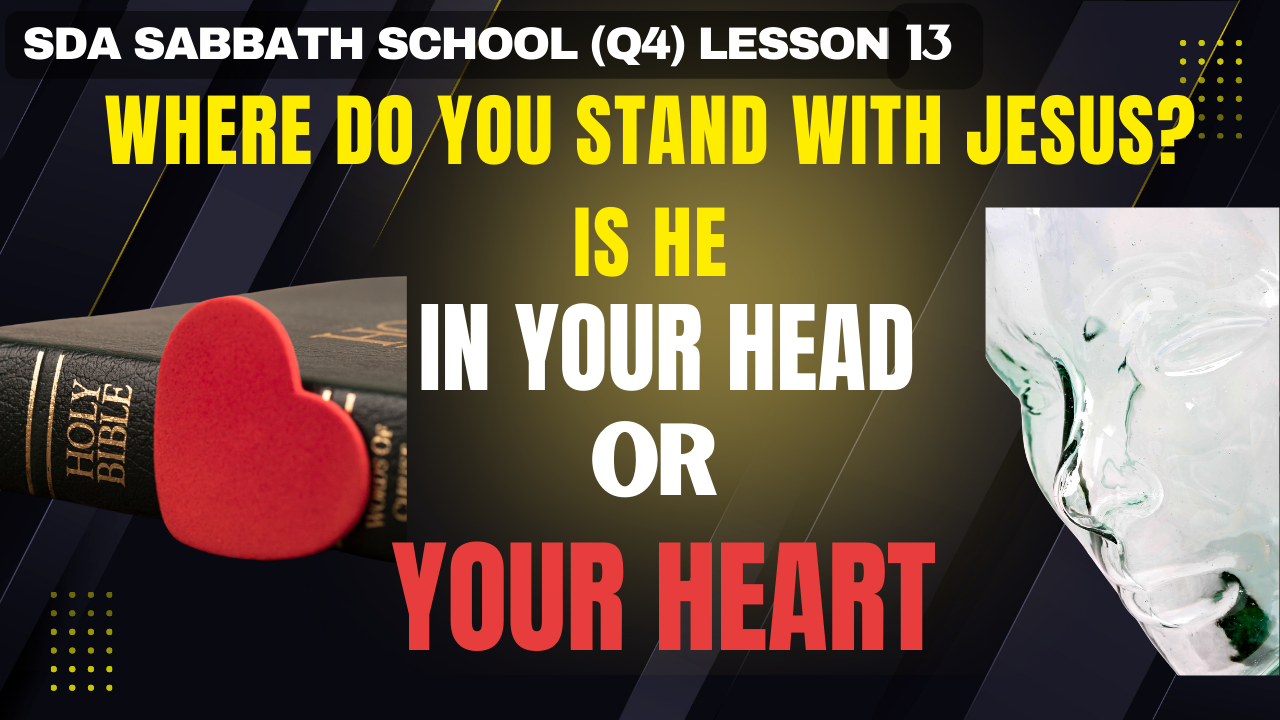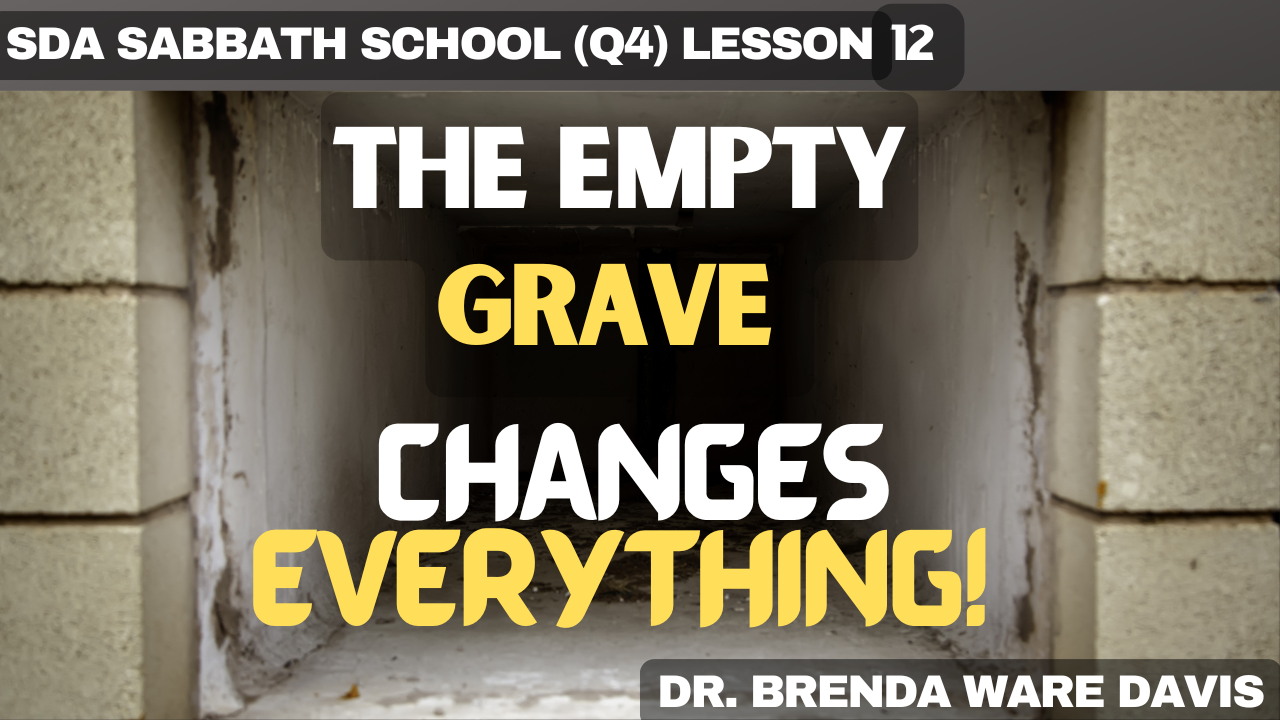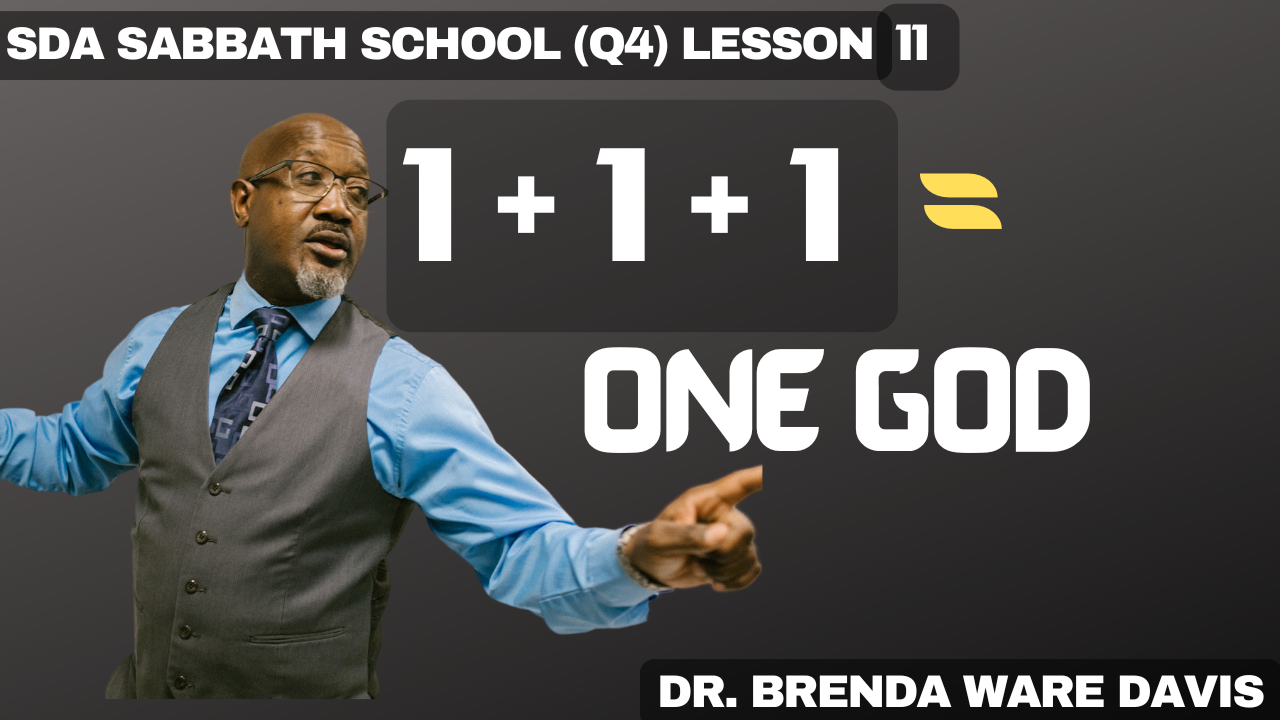The Gospel of John (Lesson 5) The Testimony of the Samaritans
JESUS’ VIEW ON BORDER WALLS
Although border walls may be great in terms of addressing such issues as National Security, Immigration Control, Economic Concerns, Territorial Disputes, and the Prevention of Crime and Drug Smuggling, they are often controversial.
They also raise concerns on such issues as human rights, environmental impacts, and their long-term effects on society.
What was Jesus’s view on border walls?
Welcome back to our series on the unique message of the Gospel of John.
John’s Gospel gives us an up-close look at Jesus’s personal interaction with individuals.
His stories reveal deep truths about Jesus, who He is, and what He means to us.
Here, we examine the lives of individuals who successfully seize opportunities while others fail to do so.
Stay with us throughout the entire series by subscribing to my YouTube Channel, Sabbath School Daily by DrBrenda Ware Davis, or visiting my Website, SabbathSchoolDaily.com.
This journey through John will help you get to know Jesus intimately and personally.
It will help you decide how to relate to him and even give you the evidence you need to decide how to respond to Him.
As always, before we begin, let’s Pray.
Inviting God’s Presence.
Heavenly Father, thank you for your divine grace.
Give us humble hearts and open minds to receive what the Holy Spirit says to us.
In Jesus Name, Amen
The Gospel of John
(Lesson 5)
Witnesses of Christ as the Messiah
Part 1 Introduction
During the time of Christ:
In the temple at Jerusalem a low wall separated the outer court from all other portions of the sacred building.
Upon this wall were inscriptions in different languages, stating that none but Jews were allowed to pass this boundary. (The Desire of Ages, p. 193.)
But not so with Jesus, He brings people together.
He breaks down walls that keep us apart.
Whether we are from different countries, cultures, or backgrounds, He invites us to come as one.
There is no border wall in Christ.
He sees no lines or divisions between us.
Just like when He spoke to the Samaritan woman at the well, Jesus shows us that love and salvation are open to everyone who desires it.
In Christ day, there was a group of people called the Samaritans.
The Samaritans were despised by their Jewish neighbors.
The Jews despised the Samaritans even more than they despised their Roman oppressors.
The Samaritans were viewed as corrupt, insincere, and to be avoided at all cost.
The “Samaritan problem” begins with the actions of Ti-glath-Pi-le-ser III, an Assyrian emperor who reigned from 745 to 727 B.C.
He initiated the process of deporting a significant portion of the population of the northern kingdom of Israel to Assyria.
These deported Israelites are often referred to as part of the “ten lost tribes of Israel” because they were largely lost to history after their displacement.
After Tiglath-Pileser III, Sargon II became the Assyrian emperor (722–705 BC) and continued this policy of depopulation.
He exiled even more inhabitants from the Northern Kingdom, further depleting its native population.
To stabilize and unify the vast territories of the Assyrian Empire, the Assyrian rulers implemented a resettlement policy.
They brought in people from other parts of Assyria and the broader Mesopotamian region to repopulate the areas in the northern kingdom of Israel that had been depopulated by the deportations.
The newcomers who settled in the region mixed with the remaining Israelites who had not been deported.
This mixing was not only racial but also religious, as the settlers brought with them their own religious practices, which blended with the local Israelite religion. ({aiseee😉)
Over time, this resulted in significant cultural and religious differences between the new inhabitants (who would become known as Samaritans) and the remaining Israelites.
The intermingled population in the former Northern Kingdom gradually developed into the distinct community known as the Samaria.
They had their own religious practices centered around Mount Gerizim, distinct from the Jewish worship in Jerusalem.
This series of events resulted in the deep-seated animosities and cultural divisions between the Israelites of the northern kingdom (the Samaritans) and the Israelites of the southern kingdom (Judah), shaping interactions and attitudes for centuries.
When the Jewish people returned from exile to rebuild their temple in Jerusalem, the Samaritans worked against the rebuilding of the temple at the return of the Jews from Babylon.
Instead, the Samaritans built their own temple on Mount Ge-ri-zim.
But in 128 B.C., a Jewish leader named John Hyr-ca-nus destroyed the Samaritan temple.
This animosity between Jews and Samaritans still existed at the time of Christ.
Although they might do business with each other, that was it.
They didn’t help or trust each other, and they stayed separate.
The Jews avoided Samaria as much as possible.
They generally avoided any social interactions with them, refusing to borrow from them or accept any favors from them.
Within this backdrop, the Gospel of John describes an interaction between Jesus and a Samaritan woman at a well, and Jesus’ later dealings with the residents of Sychar, a Samaritan city.
In John 4:42 when the woman told the people in her town about Jesus, they said, (Paueew)
‘Now we believe, not because of what you said, for we ourselves have heard Him and we know that this is indeed the Christ, the Savior of the world’ ” (John 4:42, NKJV).
Jesus didn’t care about the divisions between Jews and Samaritans.
He came to break down those barriers.
As you view the rest of this video, think about how you can remove those border walls by showing love and kindness to those different from you even as it relates to political parties.
Being that the Samaritans were so taboo among the Jews, how did Jesus end up in Samaria?
Read John 3:26-30 and John 4:1-9
Then continue to Part 2: The Setting of the Encounter
The Gospel of John
(Lesson 5)
The Testimony of the Samaritans
Part 2: The Setting of the Encounter
Jesus always saw people, not barriers.
He looked beyond differences, beyond conflicts, and beyond traditions, beyond status.
His mission was to show God’s love to everyone, no matter who they were or where they came from.
Jesus didn’t take the long way around Samaria like most Jews did.
He went straight through it because He knew there were people who needed to have an encounter with Him.
The Pharisees, the religious leaders of that day, had noticed that the disciples of Jesus were baptizing more people than those of John the Baptist.
This could potentially stir up opposition between Jesus’ disciples and John the Baptist’s disciples.
John’s followers became upset because it looked like their leader John the Baptist was being replaced.
Naturally, as disciples of John the Baptist, they were being protective of his status and reputation.
John 3:26 -29 says
26 And they came to John and said to him, “Rabbi, He who was with you beyond the Jordan, to whom you have testified—behold, He is baptizing, and all are coming to Him!”
27 John answered and said, “A man can receive nothing unless it has been given to him from heaven.
28 You yourselves bear me witness, that I said, ‘I am not the Christ,’ but, ‘I have been sent before Him.’
29 He who has the bride is the bridegroom; but the friend of the bridegroom, who stands and hears him, rejoices greatly because of the bridegroom’s voice. Therefore this joy of mine is fulfilled. (John 3:26 -29)
So, John tells them not to worry. He says in verse
30 He must increase, but I must decrease. (John 3:30).
Although John wasn’t upset about the increased number of baptisms among Jesus’ disciples, to avoid conflict between His followers and John’s followers, Jesus left Judea and headed to Galilee.
Now, the quickest way to get there was through Samaria, so He went straight through it, even though most Jews would have taken the long way around, going east to Perea to avoid the Samaritans.
But there was a work for Jesus in Samaria.
When Jesus arrived in Samaria, He stopped at a place called Jacob’s well, near the city of Sychar.
He was tired and thirsty, so He sat down by the well while His disciples went into the city to buy food.
Soon, a Samaritan woman came to the well to get water.
Jesus used his thirst as an opportunity to open a conversation with this woman.
So, Jesus asked her for a drink.
“The hatred between Jews and Samaritans prevented the woman from offering a kindness to Jesus; but the Saviour was seeking to find the key to this heart, and with the tact born of divine love, He asked, not offered, a favor. The offer of a kindness might have been rejected; but trust awakens trust.”—Ellen G. White, The Desire of Ages, p. 184.
This was surprising to the women because Jews didn’t usually talk to Samaritans.
As in John 3, it was surprising that Nicodemus, a ruler of the Jews and a rabbi, would lower himself to come to Jesus by night to avoid being seen.
What’s strange here is that the women usually came to the well in the cooler parts of the day—morning or evening—but this woman, according to John 4, came in the middle of the day, a time when it is hottest.
Why, it is not known, but maybe it was to avoid contact with the other women who came either at the beginning or end of the day when it was cooler.
But Jesus didn’t care about any of that.
He started talking to her.
As the scene unfolds, a Jewish teacher (Jesus) is compared to a Samaritan woman of poor reputation.
However, in this exact context, a remarkable encounter unfolds.
At first, the woman is confused.
She didn’t know who Jesus was.
But as they talked, she began to realize that this man wasn’t just an ordinary Jew.
He was special.
She said, in John 4:19, “Sir, I can see that you are a prophet” (John 4:19).
This woman’s encounter with Jesus was about to changed her life.
Jesus came to tear down walls.
In John 4, we see how Jesus used this moment at the well to start a conversation about something, a different kind of water, water that did not come from that well.
What kind of water is it? Read John 4:7-15
Then, View the next segment of this video, Part 3: The Women at the Well
The Gospel of John
(Lesson 5)
The Testimony of the Samaritans
Part 3: The Women at the Well
Jesus knew how to reach people in ways that made them feel seen and valued.
Even in simple conversations, He shared deep truths about God’s love for them.
In His meeting with the Samaritan woman at the well, Jesus used this unusual encounter to teach her about “living water.”
“The hatred between Jews and Samaritans prevented the woman from offering a kindness to Jesus; but the Saviour was seeking to find the key to this heart, and with the tact born of divine love, He asked, not offered, a favor. The offer of a kindness might have been rejected; but trust awakens trust.”—Ellen G. White, The Desire of Ages, p. 184.
In John 4:7-15, as expressed we read about Jesus meeting this Samaritan woman by a well.
Jesus was tired and thirsty, so He asked the woman for a drink.
Now, this of course was unusual because Jews and Samaritans didn’t talk to each other.
The hatred between them ran deep, but Jesus didn’t let that stop Him from reaching out to her.
The woman was surprised that Jesus, a Jew, would even ask her for a drink. (Pause)
She knew how much Jews avoided Samaritans.
But Jesus had a plan.
He wanted to touch her heart, and He knew exactly how to do it.
As was the case in His encounter with Nicodemus, Jesus knows what is in the woman’s heart.
In response to her surprise that a Jew would ask such a favor of a Samaritan, Jesus cuts right through the case and gets directly to the point.
Jesus says to her,
“ ‘If you knew the gift of God, and who it is who says to you, “Give Me a drink,” you would have asked Him, and He would have given you living water’ ” (John 4:10, NKJV).
The woman’s response was like that of Nicodemus, who asked, concerning the new birth.
“ ‘How can these things be?’ ” (John 3:9, NKJV)
Looking at the well she asked:
“ ‘You have nothing to draw with, and the well is deep. Where then do You get that living water?’ ” (John 4:11, NKJV).
She was thinking about physical water, just like Nicodemus in John 3.
He didn’t understand when Jesus talked about being born again. But Jesus was talking about something much greater.
He was basically telling them the same thing: they needed a conversion experience that involved the process in which an individual turns away from sin and embraces God through faith in Jesus Christ.
In both cases, Jesus was teaching an important spiritual truth to two very different people: one was a well-known Jewish teacher, and the other was a Samaritan woman with a questionable past.
In each situation, Jesus was telling them the same thing: they both needed to change their hearts and lives through a conversion experience.
In the Old Testament, living water is a symbol of life and salvation.
Jeremiah 2:13 talks about how people turn away from the true “spring of living water,” which is God,
13 “For My people have committed two evils: They have forsaken Me, the fountain of living waters, And hewn themselves cisterns—broken cisterns that can hold no water. (Jeremiah 2:13)
and Zechariah 14:8 speaks of living water flowing from Jerusalem.
8 And in that day it shall be That living waters shall flow from Jerusalem, Half of them toward the eastern sea And half of them toward the western sea; In both summer and winter it shall occur. (Zechariah 14:8)
Jesus used this familiar idea to show the woman that He offered her something more than physical water.
Water is essential for life; we can’t live without it.
Therefore it is suitable to use water as a powerful image of eternal life.
Hence Jesus says, “Whoever drinks the water I give them will never be thirsty again. Instead, the water I give them will become a spring of water inside them, bubbling up into everlasting life” (John 4:14, NKJV).
Jesus was talking about the spiritual life that only He could give.
It is everlasting life that satisfies our deepest thirst.
Just like we need water to live physically, we need Jesus to live spiritually.
Without Him, our hearts are empty, just like our bodies feel when we’re thirsty.
But Jesus promises that if we come to Him, He will give us the living water of eternal life, and we will never thirst again.
For instance, in John 7:37-38, it says
37 On the last day, that great day of the feast, Jesus stood and cried out, saying, “If anyone thirsts, let him come to Me and drink.
38 He who believes in Me, as the Scripture has said, out of his heart will flow rivers of living water.” (John 7:37-38)
When Jesus talked to the Samaritan woman, He showed her that even though she was a Samaritan and even though she had made mistakes in her life, she was still valuable to God.
He offered her the living water of salvation.
Jesus didn’t let the hatred between Jews and Samaritans stop Him from reaching out to her.
He knew what was in her heart, and He knew she needed Him.
After hearing His words, how did the woman respond?
Read John 4:15 again.
Then, Continue to the next segment of this video, Part 4: “ ‘Sir, Give Me This Water’ ”
The Gospel of John
(Lesson 5)
The Testimony of the Samaritans
Part 4: “‘Sir, Give Me This Water’”
God offers to clean us from the inside out.
He promises to give us new hearts and fill us with His Spirit so we can live differently.
In Ezekiel 36:25–27, God tells us He will replace our hearts of stone, hard hearts with hearts of flesh, gentle ones, and His Spirit will help us follow Him.
Jesus wanted to teach these truths to both Nicodemus and the Samaritan woman, with no borders walls between, showing them that they both needed a heart change that only God can provide.
25 Then I will sprinkle clean water on you, and you shall be clean; I will cleanse you from all your filthiness and from all your idols.
26 I will give you a new heart and put a new spirit within you; I will take the heart of stone out of your flesh and give you a heart of flesh.
27 I will put My Spirit within you and cause you to walk in My statutes, and you will keep My judgments and do them. (Ezekiel 36:25-27)
In both the story of Nicodemus and the woman at the well, Jesus seeking to help them understand these deep spiritual truths.
He want them see God desire to bring change into their lives.
So, He used simple illustrations from the natural world such as birth and water to make these truths clear.
Nicodemus, a religious leader, came to Jesus at night.
He wanted to understand what Jesus was teaching, but when Jesus told him he must be “born again” to see God’s kingdom, Nicodemus didn’t get it.
He asked, “How can a man be born when he is old?
Can he go back into his mother’s womb?” (John 3:4).
Nicodemus thought Jesus was talking about physical birth, but Jesus was talking about spiritual rebirth—a new beginning in the heart.
Similarly, when Jesus spoke to the Samaritan woman, she also misunderstood His message at first.
He told her about “living water,” which would quench her thirst forever.
The woman thought Jesus was talking about the water from the well.
She said, “Sir, give me this water, that I may not thirst, nor come here to draw.” (John 4:15).
She didn’t realize that Jesus was offering her something much greater—spiritual water that would satisfy her thirty soul.
In both cases, Jesus was teaching that we need more than just physical things to live.
We need a new heart, a heart that is clean and filled with God’s Spirit.
This is exactly what Ezekiel 36:25–27 talks about. God says, “I will sprinkle clean water on you, and you will be clean. I will give you a new heart and put a new spirit in you.”
Just like we need water to clean our bodies, we need God’s Spirit to clean our hearts.
When the Samaritan woman asked for the living water, she thought the water Jesus offered meant she wouldn’t have to go to the well anymore, which would keep her from having to meet others there.
What’s interesting is how quickly their conversation went from Jesus asking her for water to her asking Jesus for water.
From her request for water, Jesus suddenly changed the topic.
In John 4:16
16 Jesus said to her, “Go, call your husband, and come here.” (John 4:16)
He told her to go get her husband, even though He knew she didn’t have one.
In fact, she had been married five times and the one she was living with was not her husband.
Why did Jesus suddenly change the subject?
He was helping her see the truth about her life.
She had been avoiding her present reality.
However, as with Nicodemus, Jesus could read her heart.
She must be willing to face her present situation before healing could take place.
Jesus saw that she needed to admit her sin and realize her need for forgiveness before she could receive the living water.
Ellen G. White explains that “Before this soul could receive the gift He longed to bestow, she must be brought to recognize her sin and her Saviour.”— (The Desire of Ages, p. 187).
Jesus wasn’t trying to shame her; He was leading her to see that she needed His help.
Once she recognized her need, she could receive the new life He offered.
In Jesus’ time, there was a huge difference between how Jews and Samaritans worshiped God. (Pause)
Although the Pharisees, who were Jewish leaders, looked down on the Samaritans and considered them unworthy of God’s blessings,
Jesus wasn’t interested in the old divisions between people.
He came to show that true worship is about the heart and receiving the Messiah.
How did Jesus reveal Himself to her? Read John 14:16-26.
Then, continue to the next segment of this video: Part 5: The Revelation of Jesus
The Gospel of John
(Lesson 5)
The Testimony of the Samaritans
Part 5: Revelation of Jesus
When Jesus meets the Samaritan woman at the well, He does more than just offer her living water.
He reveals that He knows the deepest parts of her life—the secrets she has been hiding.
Through this, Jesus shows us that He sees us as we are, but also offers us the love, compassion, forgiveness and the truth we need to be set free.
In John 4:16-24, we see Jesus gently confronting the Samaritan woman with the truth about her life.
After offering her living water, Jesus asks her to go and get her husband. The woman responds by saying, “I don’t have a husband” (John 4:17).
Jesus then reveals that He knows her situation fully: “You’re right—you’ve had five husbands, and the man you’re living with now isn’t your husband” (John 4:18).
This moment is powerful because it shows that Jesus knows everything about this woman’s life, even the things she’s tried to hide.
Her broken relationships and current living situation were likely a source of shame for her, and yet, Jesus brings them into the open, not to condemn her, but to help her.
The woman, understandably, tries to avoid the painful truth.
Instead of talking about her personal life, she changes the subject to something less uncomfortable.
Recognizing Jesus as a prophet, she turned the table and asked Jesus a controversial question related to the religious disagreement found between the Jews and Samaritans regarding the proper place to worship God.
The Jews believed Jerusalem was the only place to worship, while the Samaritans worshiped on Mount Ger-i-zim.
In response, Jesus tells her that the Samaritans didn’t fully understand what they were worshiping.
Their religion was a mixture of Jewish beliefs and paganism.
He explained that the Jews worshiped the God who reveals Himself clearly.
This was significant for a Samaritan to hear.
Jesus goes on to explain that true worship is not tied to a physical place.
Thus, the issue of worship in this conversation was irrelevant.
In John 4:23-24, Jesus tells her
23 But an hour is coming, and now is, when the true worshipers will worship the Father in spirit and truth; for such people the Father seeks to be His worshipers.
24 God is spirit, and those who worship Him must worship in spirit and truth.”(John 4:23-24).
Jesus makes it clear that worshiping God is not about where you are but about having a heart that seeks God in sincerity of heart and truth.
The woman begins to understand.
She recognizes that Jesus is more than just a prophet.
She realizes that Jesus is revealing something deeper, something spiritual that goes beyond the usual religious battle between Jews and Samaritans.
Jesus’ answer opens her heart to the truth.
The woman accepted the plain truth Jesus presents and is ready to receive more.
At this point, Jesus reveals to her who He really is.
In John 4:25-26, the woman says,
“I know that Messiah is coming” (who is called Christ). “When He comes, He will tell us all things.”
Then, 6 Jesus said to her, “I who speak to you am He.” (John 4:25-26)
This is a significant moment in the New Testament because this is the only passage before His trial in which Jesus openly reveals that He is the Savior, the Messiah.
Interestingly, Jesus did not tell a large crowd or religious leaders that, but He reveals his identity to this unnamed Samaritan woman, alone, at Jacob’s well, to someone who was living in sin and considered an outsider.
This shows us that Jesus is deeply interested in these individuals, especially those who feel lonely or separated from others. (Pause)
So, to this Samaritan woman, a foreigner with a life marked by brokenness and shame, Jesus offering her living water, openly reveals Himself to her.
By revealing her deepest dark secrets, He also gave her a reason to believe in Him.
Jesus’ interaction with this Samaritan woman teaches us that we often hide parts of ourselves from others because of shame or fear.
Sometimes, we avoid facing the truth about our own lives, just as the Samaritan woman did when she tried to change the subject from her personal life to religious debates.
But Jesus doesn’t let us stay in hiding.
He gently brings our hidden struggles to the surface, not to shame us, but to heal us.
When we allow Jesus to confront the parts of our lives we’d rather ignore, He can bring us the freedom and peace we long for.
Jesus also begins to break down the border wall between Jews and Gentiles. (Pause)
At the time, Jews and Samaritans didn’t interact.
But Jesus didn’t support these customs.
How did Jesus show that he did not support this separation between the Jews and the Samaritans?
Read John 4:27-42
Then, continue to the next segment of this video, Part 6: The Testimony of the Samaritan
The Gospel of John
(Lesson 5)
The Testimony of the Samaritans
Part 6: The Testimony of the Samaritans
In Jesus’ encounter with the Samaritan woman at the well, He didn’t just transform her life.
This encounter also showed us the power of sharing our personal experiences with others.
The woman’s unexpected reaction after meeting Jesus teaches us a valuable lesson about how we can share the Good News and lead others to believe in Him.
In John 4:27-29, something surprising happens.
The disciples return to find Jesus speaking with the Samaritan woman.
They’re shocked to see Him talking with her because, in their culture, in Jesus’ day, it was uncommon for Jewish men to talk to women in public, especially a Samaritan woman.
The Jewish social norms were quite strict about interactions between men and women who were not related.
This cultural practice aimed to maintain decency and avoid any appearance of bad behavior.
Jesus’ interactions with women, such as speaking with the Samaritan woman at the well, were significant because He broke these conventional social norms and highlighted His inclusiveness in teaching and ministry.
So although surprised to see Jesus talking to this Samaritan women, the disciples don’t question him, they instead try to get Him to eat something.
In the meantime, the woman is so moved by her conversation with Jesus that she forgets all about her water pot.
This is surprising because she had come to the well to draw water, but after meeting Jesus, her priorities completely shift.
She leaves her water pot behind and runs back to the city, eager to tell others what she has just experienced with Jesus.
She says in John 4:29,
29 “Come, see a Man who told me all things that I ever did. Could this be the Christ?” (John 4:29).
The woman’s actions are amazing because she was previously avoiding people, likely due to the shame she felt about her past.
But now, she boldly runs to the very people she had been avoiding to tell them about Jesus.
Her encounter with Jesus gave her new confidence, and she couldn’t keep her story to herself.
After the woman shares her story, many people from the city come out to meet Jesus for themselves.
They believe in Him, first because of the woman’s testimony and then because of what they hear directly from Jesus.
The Samaritans are so impressed with Jesus, they asked Jesus to stay with them.
The result was that many more believed because of the Word of Jesus.
John 4: 42 says 42 Then they said to the woman, “Now we believe, not because of what you said, for we ourselves have heard Him and we know that this is indeed the Christ, the Savior of the world.” (John 4:42).
This shows just how powerful one person’s story about Jesus can be.
It was the woman’s personal experience that first brought people to meet Jesus, and then their own encounter with Him confirmed their faith.
This story teaches us an important lesson about sharing Jesus with others.
You don’t need to know everything to tell people about Jesus.
The Samaritan woman didn’t have all the answers, but she shared what she knew:
Jesus had touched her life in a way no one else could.
Her simple testimony led many others to discover Jesus for themselves.
In the middle of this story, Jesus teaches His disciples a lesson.
When they urge Him to eat, Jesus replies,
“My food is to do the will of Him who sent me and to finish His work” (John 4:34).
He uses the example of harvesting crops to explain that the time to share the Good News is now.
The disciples didn’t see the Samaritans as ready for salvation, but Jesus did.
He shows them that the harvest—the opportunity to reach people—is already here, even among those who are different from them.
Jesus’ mission on earth was to save people from sin, and He wasn’t going to let the border walls of culture, race, ethnicity, nationality or prejudices stop Him from sharing God’s love.
Note: the Samaritans didn’t need signs or miracles to believe in Jesus. They accepted Him simply because of His words and the testimony of the woman at the well. While the Pharisees ignored Jesus’ miracles and demanded proof of His identity, the Samaritans welcomed Him as the Messiah, not just for the Jews but for the whole world (The Desire of Ages, pp. 192-193).
Jesus’ stay in Samaria was also a blessing to His disciples, who still struggled with Jewish prejudices against Samaritans. By staying in their town, eating their food, and treating them with kindness, Jesus showed His disciples that the Good News was for everyone, not just for a select group. It was a lesson in breaking down barriers and seeing people as children of God, no matter where they come from (The Desire of Ages, p. 193).
The Samaritan woman’s story shows us that anyone can be a witness for Jesus. She became a more effective missionary than Jesus’ own disciples at that moment. While the disciples didn’t see Samaria as a place ready for the Gospel, the woman did. She immediately shared the light she received from Jesus, and her testimony led many others to believe. This reminds us that when we receive the grace of Christ, it overflows into the lives of others. Just like the living water Jesus spoke about, His love in our hearts becomes a fountain that refreshes those around us (The Desire of Ages, p. 195).
The Samaritan Woman’s simple testimony led an entire city to meet Jesus.
Her story can be Your story.
Your story can be just as powerful in bringing others to Him.
What has Jesus done for you.
Your personal experience with Jesus is powerful testimony.
You don’t have to know everything to tell others about Him—just share what you do know.
Your story could be the spark that leads someone else to discover Jesus for themselves.
In Jesus the Christ, there are no border walls.
———————————————–
Thank you for watching this video.
To be notified when my next video is released, Subscribe to my YouTube Channel, SabbathSchoolDaily by Dr. Brenda Ware Davis. (Pause)
You may watch many of my other videos @ SabbathSchooldaily.com
You may obtain a free study guide for this series at Sabbath.School or ssnet.org
If you enjoyed this video, click Like…..Then…..Share.
Thank you for Liking, Sharing, and Subscribing.
Hebron Seventh-day Adventist Church
7902 Wheatly Street
Houston, TX 77088
hebrontx.adventistchurch.org
Watch Past and Present Lessons at SabbathSchoolDaily.com














Post Comment